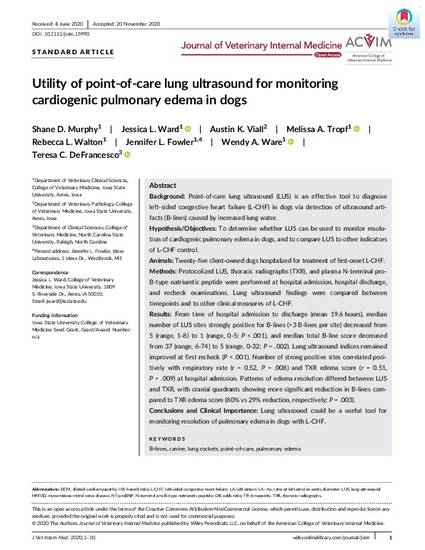
Background Point‐of‐care lung ultrasound (LUS) is an effective tool to diagnose left‐sided congestive heart failure (L‐CHF) in dogs via detection of ultrasound artifacts (B‐lines) caused by increased lung water.
Hypothesis/Objectives To determine whether LUS can be used to monitor resolution of cardiogenic pulmonary edema in dogs, and to compare LUS to other indicators of L‐CHF control.
Animals Twenty‐five client‐owned dogs hospitalized for treatment of first‐onset L‐CHF.
Methods Protocolized LUS, thoracic radiographs (TXR), and plasma N‐terminal pro‐B‐type natriuretic peptide were performed at hospital admission, hospital discharge, and recheck examinations. Lung ultrasound findings were compared between timepoints and to other clinical measures of L‐CHF.
Results From time of hospital admission to discharge (mean 19.6 hours), median number of LUS sites strongly positive for B‐lines (>3 B‐lines per site) decreased from 5 (range, 1‐8) to 1 (range, 0‐5; P < .001), and median total B‐line score decreased from 37 (range, 6‐74) to 5 (range, 0‐32; P = .002). Lung ultrasound indices remained improved at first recheck (P < .001). Number of strong positive sites correlated positively with respiratory rate (r = 0.52, P = .008) and TXR edema score (r = 0.51, P = .009) at hospital admission. Patterns of edema resolution differed between LUS and TXR, with cranial quadrants showing more significant reduction in B‐lines compared to TXR edema score (80% vs 29% reduction, respectively; P = .003).
Conclusions and Clinical Importance Lung ultrasound could be a useful tool for monitoring resolution of pulmonary edema in dogs with L‐CHF.
Available at: http://works.bepress.com/jessica-ward/11/

This is the published version of the following article: Murphy, Shane D., Jessica L. Ward, Austin K. Viall, Melissa A. Tropf, Rebecca L. Walton, Jennifer L. Fowler, Wendy A. Ware, and Teresa C. DeFrancesco. "Utility of point‐of‐care lung ultrasound for monitoring cardiogenic pulmonary edema in dogs." Journal of Veterinary Internal Medicine (2020). DOI: 10.1111/jvim.15990. Posted with permission.